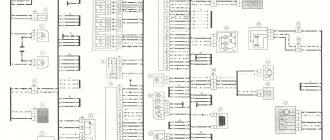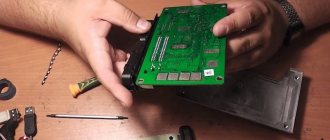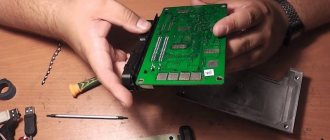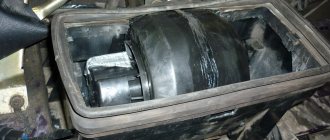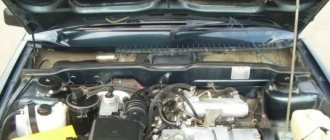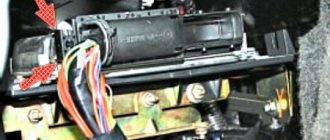High-quality operation of a car’s heater in winter is one of the main conditions for comfortable driving. In domestic vehicles, even in new models, the heater is one of the problematic elements that very often fails. And if in the summer you can turn a blind eye to this, then in cold weather you immediately have to take measures to eliminate the problem.
To eliminate the malfunction, it is first important to diagnose which element of the car’s heating system has failed and repair the non-functioning unit. The easiest way is to turn to specialists for help, but their services are not very cheap. Very often, vehicle owners troubleshoot and repair the heater on their own, since domestic cars are highly maintainable.
Heater regulator on the dashboard of a VAZ 2110
This article will talk about how to diagnose a malfunction of the VAZ-2110 heater control unit and repair it yourself.
Design features of the VAZ-2110 stove control unit
One of the common heating system problems that VAZ-2110 owners encounter is the failure or malfunction of the heater control unit. Dozens of them are equipped from the factory with stoves, which are coordinated through an automatic heater control system. In short, the system is called the SAUO block. The main indicators of its malfunction are the operation of the heating system not in all modes. If one or more stove speeds do not work, then most often the problem is in the ACS unit. Thanks to the electronic module of the VAZ-2110, the temperature set by the driver is maintained in the car interior.
Diagram of the automatic heater control system: 1 – fan electric motor; 2 – additional resistor; 3 – controller; 4 – mounting block; 5 – ignition switch; 6 – cabin air temperature sensor; 7 – recirculation switch; 8 – recirculation valve; 9 – micromotor gearbox for heater damper drive; A – to the instrument lighting switch; B – to power supplies
Before you begin repairing the VAZ-2110 heater, you need to find out what kind of heater is on your vehicle. Cars that were produced before September 2003 are equipped with old-style stoves. Accordingly, there are significant differences in the design, which are important to pay attention to during repairs.
The ACS unit consists of electronic elements, which are coordinated using handles on the central console of the machine.
The VAZ-2110 stove control unit is equipped with a controller with two handles. The right handle is responsible for turning on a certain fan speed. An additional resistor is directly responsible for switching its speeds. Old style stoves have resistors for two or three fan speeds. The new model stoves have a modified resistor RDO 2123–2118022. The unit for coordinating the operation of the improved stove model has four speeds and does not have an auto mode.
Control unit for an improved model of the VAZ 2110 heater
The left handle is responsible for turning on the temperature mode in the vehicle interior. Depending on the position of the handle, information about the set air temperature is supplied to the micro-reducer of the damper drive and, using the controller, the required position of the damper is set. Using the regulator, you can set the temperature from sixteen to thirty degrees Celsius.
Until 2003, cars were equipped with old-style stoves with four- and five-position controllers, which are now out of production and are very difficult to find. Also, the simple VAZ-2110 heater control unit is not suitable for car models that were produced after 2003 and are equipped with modified stoves from the factory.
Accordingly, before buying parts to repair the heating system of a vehicle, you need to look in the technical documentation to find out which heater model is on your top ten. The stoves differ not only in the ACS unit, but also in the heater radiator, micro-reducer, and resistors.
Stories from our readers
“Fucking basin. "
Hi all! My name is Mikhail, now I’ll tell you a story about how I managed to exchange my two-wheeler for a 2010 Camry. It all started with the fact that I began to be wildly irritated by the breakdowns of the two-wheeler, it seemed like nothing serious was broken, but damn it, there were so many little things that really started to irritate me. This is where the idea arose that it was time to change the car to a foreign car. The choice fell on the melting Camry of the tenth years.
Yes, I had matured morally, but financially I just couldn’t handle it. I’ll say right away that I am against loans and taking a car, especially not a new one, on credit is unreasonable. My salary is 24k a month, so collecting 600-700 thousand is almost impossible for me. I started looking for different ways to make money on the Internet. You can’t imagine how many scams there are, what I haven’t tried: sports betting, network marketing, and even the volcano casino, where I successfully lost about 10 thousand ((The only direction in which it seemed to me that I could make money was currency trading on the stock exchange, they call it Forex. But when I started delving into it, I realized that it was very difficult for me. I continued to dig further and came across binary options. The essence is the same as in Forex, but it’s much easier to understand. I started reading forums, studying trading strategies. I tried it on a demo account, then opened a real account. To be honest, I didn’t manage to start earning money right away, until I understood all the mechanics of options, I lost about 3,000 rubles, but as it turned out, it was a precious experience. Now I earn 5-7 thousand rubles a day. I managed to get the car buy after half a year, but in my opinion this is a good result, and it’s not about the car, my life has changed, I naturally quit my job, I have more free time for myself and my family. You’ll laugh, but I work directly on the phone)) If If you want to change your life like me, then here’s what I advise you to do right now: 1. Register on the site 2. Practice on a Demo account (it’s free). 3. As soon as you get something on the Demo account, top up your REAL ACCOUNT and go to REAL MONEY! I also advise you to download the application to your phone, it’s much more convenient to work from your phone. Download here.
Diagnostics of serviceability and dismantling of the stove control unit
The SAUO module is located on the center console of the car and is responsible for proper heating of the interior. Repairing the VAZ-2110 stove control unit requires certain knowledge in electronics, so before you begin repairing the part, you need to determine whether the problem is really in the electronic module itself.
To do this, you must initially dismantle the unit and install a known-good part in its place. Take the SAUO unit from friends or at a service center to diagnose the heating system of your car.
Before performing any work on the vehicle that involves electronics or wiring, turn off power to the battery to avoid shorting or burning out the electronic components.
Then you can proceed directly to removing the unit through which the functionality of the stove is coordinated. To do this, the buttons that are located on the sides of the stove are initially dismantled. The heater controls must be switched to zero positions. Only then can the module be pulled out. This must be done very carefully, since the power plugs are connected to the back of the unit. As soon as you see them, they must be carefully disconnected so as not to damage the contacts. At this point, dismantling can be considered complete.
The working unit is installed on the standard seat, and the operation of the vehicle’s heating system is checked. If the stove functions correctly with the new unit, then the fault is in the ACS unit itself. Otherwise, it is necessary to diagnose other elements of the heating system.
Diagnosis of the problem
If the reason why the VAZ-2110 stove does not work is the damper, it is not difficult to identify it. To do this, disassemble the central deflector, turn on the ignition and rotate the temperature setting knob to its extreme positions. In a working stove, the central damper will not knock and will completely open and close the air supply channel.
If the heater damper does not move or stops in a position that does not completely block the air passage, it may be stuck. You can verify this by pushing the valve with your hand or a long rod. If after this the damper returns to its normal position, then this is the reason why it is jammed. Through the mounting hole of the deflector, you can assess the condition of the damper and its seals. If the damper is deformed, its bend is clearly visible.
DIY repair of the VAZ-2110 heater control unit
If during diagnostics it turns out that the problem is in the heater control module, then you need to try to repair it or install a new part. Since the price of new electronic units is quite high, the right decision would be to repair the control part, especially since this requires only basic knowledge of electronics, the ability to use a tester and a soldering iron if necessary.
Before you begin, you need to disassemble the heater control unit. To do this, the front cover with regulators is removed from the latches from the previously dismantled electronic module. Next, a special glass cover is detached. Using a screwdriver, unscrew two screws on the front panel of the unit and one on the rear wall. After this, the top cover of the module can be removed; this must be done very carefully so as not to damage the contacts inside the part.
Inside the module there are electronic tracks, contacts and resistors that are responsible for the high-quality functioning of the vehicle’s heating system controllers. It is necessary to inspect all contacts, electronic tracks on the board, resistors and jumpers. High operating temperatures can cause the board to become very hot, which will lead to disconnection of the contacts. Particular attention should be paid to the power supply points and the contacts should be cleaned. If there is visible damage to the electronic circuit, it is necessary to solder the damaged elements. In parallel, using a tester and an ohmmeter, the functionality of the electronic elements and resistors located on the board is checked. If necessary, non-functioning parts on the ACS module board are replaced.
Broken jumper on the board of the heating control unit VAZ 2110
After troubleshooting, the heater control unit is assembled in the reverse order and installed in its original place. Next, you need to connect the battery power and check the operation of the vehicle’s heating system; if necessary, adjust the heater controller.
SAUO repair
Before repairing the SAUO VAZ 2110 unit, you should make sure that the problems with the stove are associated with it. To do this, you should connect a known working heater control unit (borrow from a friend or from a store). If there are no problems with the stove with the working unit of the automatic control system, then we try to find out what the reason is. If the obviously working unit of the automatic control system did not help, then the problem with the stove is somewhere else.
Remove the buttons next to the SAUO block. We take out the stove control unit. Set the controls to position 0 and remove, and then remove the front cover and glass from the latches. Unscrew 2 screws in front and 1 in back. We remove the board from the plastic case and check the integrity of all tracks, jumpers and resistors. In this example, a broken jumper was found. We solder it on one side and the other. Reassemble in reverse order. Now all speeds of the SAUO block work .
FAQ on the operation of the VAZ 2110 stove
1st oven speed does not work
- All heater fan speeds (except the last one) are connected through an additional heater resistor, which is located under the frill (wind flap). One of the reasons when the first speed of the heater does not work is a malfunction of this resistor. Depending on the ACS unit, this additional resistor varies:
RDO 2108-8101081 is used on the oldest SAUO units, which have only 2 speeds. (0 A 1 2).
RDO 2110-8118022-01 is installed on a modified heater until September 2003, the SAUO unit has 3 speeds (0 A 1 2 3). The most common malfunction in this resistance is that all stove speeds stop working, except maximum 3. The reason is that the thermal fuse is unsoldered (indicated by a red arrow), and is treated by soldering it in place. But if it is unsoldered later, you need to look in the direction of the motor, the motor takes a very large current (not lubricated, wear on the brush assembly, etc.).
RDO 2123-2118022 has been installed on the latest heaters since September 2003, the SAUO unit has 4 speeds and does not have an auto mode (0 1 2 3 4).
- In addition to a malfunction of the additional heater resistor, the problem may also be in the contacts of the heater control unit board. Often, due to high temperatures, the board becomes very hot and the contact is soldered off. Carefully examine all contacts on the boards, especially at the power supply points.
- Clean contacts.
Heater speed 2 doesn't work
- The reason is exactly the same as in the case when the first heater speed does not work.
3rd speed heater doesn't work
- If the 3rd speed is the last, then it works without resistance (directly). And the problem may be in the contacts of the ACS unit (stripped/crimped), or in the contacts on the board of the ACS unit.
- If you have a stove control unit with 4 fan speeds (0 1 2 3 4), then look for problems with the 1st stove speed.
4th oven speed does not work
- The reason is exactly the same as in the case when the third heater speed does not work.
The stove blows equally at speeds 1 and 2, that is, there is almost no difference between the first speeds, but at speed 3 it blows much stronger
- The reason is the additional heater resistor, it needs to be replaced.
The temperature on the heater control unit is not regulated or the heater fan does not work. Disassemble the ACS unit and carefully examine all tracks and contacts. If there are no visible defects, then you need to look for the cause in the part indicated in the photo.
- Another reason could be poor contact in the fuse box. On the back of the block there is a 6-terminal chip, the blue wire on it is to the fan. Perhaps it was burnt in this connector at the connection point. It is necessary to replace the chip and crimp the new connector. Remove the block, disassemble and solder the leg (perhaps it melted and became unsoldered due to heating).
ps If there are other solutions to problems with the operation of the stove , then leave comments, we will supplement the FAQ on the operation of the SAUO unit . By the way, malfunctions in the heater can be caused by other reasons.
What most often failed in the stove of your “ten”?
Adjusting the stove controller
The manufacturing plant provides for heating the interior to the specified temperature in fifteen minutes with a deviation of up to two degrees. Use the controller knob to set a comfortable temperature in the car interior.
To check the proper functioning of the stove, use a regular mercury room thermometer. If after fifteen minutes the interior has not warmed up to the required temperature, the controller must be adjusted.
To do this, pull the heater control module back out and rotate the temperature regulator, first to the maximum value, then in the opposite direction. After carrying out such actions, install the unit in place and check the operation of the stove again.
At the same time, it is necessary to check the operation of the heater dampers. If there are extraneous sounds when switching temperature modes, then you need to check the condition of the dampers. If cold air flows well, but hot air hardly flows in, then the lower damper is faulty. If there is no normal flow of cold air but there is a good flow of hot air, there is a problem with the upper damper. The reason may be deformation of the dampers under the influence of air of different temperatures. In this case, it is better to replace the standard plastic dampers with aluminum analogues, which are more resistant to temperature changes.
After adjusting the controller, all heater elements are installed in their original places. Assembly is carried out in reverse order.
Causes of malfunctions
Depending on the design of the stove, the damper may cause a disruption in the efficient operation of the heater for the following reasons:
- deformation;
- wear of seals;
- deterioration or damage to control levers and rods;
- skew.
Deformation is a problem with old-style heaters. The first dampers of the VAZ-2110 stove were equipped with plastic elements that bent under the influence of temperature. Because of this, even when completely closed, cold air from outside leaks in and mixes with the heated air, and the efficiency of the stove decreases. Subsequently, the designers replaced the plastic flaps with aluminum ones and the problem with deformation disappeared.
To ensure tightness, the dampers have seals that reduce air leakage. Initially, foam rubber seals were used, which quickly wore out and became damaged. Later, foam rubber was replaced with rubber, but this only extended the service life of the seal; over time, the rubber ages, cracks and collapses.
Let's sum it up
Malfunctions of the VAZ-2110 heater control unit can lead to both incorrect functioning of the vehicle’s heating system and complete failure of the heater. During the cold season, this will affect not only a comfortable stay in the car, but also safe driving for the driver of the vehicle.
Repairing the stove control unit can be done on your own if you have basic knowledge of electronics, a desire to work and improve your comfort.
High-quality repairs and timely regular inspections of the unit before the onset of cold weather will help you save money on stove repair services at service centers and the purchase of expensive heating system elements.
Functions and main malfunctions of the interior temperature sensor
The heating system in cars of this brand is controlled by a signal method. The impulses come from the electrical control unit. Temperature is a factor affecting every system controlled by the unit. The essence of its work is to compare the indicators on the sensor (16-30°C) with the real heat intensity, which is measured by it.
When a temperature difference is detected, the motor turns on. Its function is to change the flow of warm air using dampers and fan speed. The cabin air temperature sensor is a thermistor or semiconductor resistor, which has a close relationship between thermal state and resistance. From the control electrical unit, voltage is supplied to this device through a resistor located inside.
One of the most traditional defects of this device, which operates on the basis of a semiconductor thermistor, is the discrepancy between the temperature of the external part and the resistance. To correct this discrepancy, you need to know the main features of its work. Typically, this defect manifests itself in a rapid increase in resistivity with small fluctuations in the degree of heating of the outer part.
In addition, there may be a break in the electrical circuit of the sensitive element of the converter itself, which is why you will have to buy a new interior temperature sensor. Periodically, a situation arises in which the thermal state of the device shell varies over a certain small range, and the resistance increases disproportionately with voltage. As a result, the heat calculated by the block turns out to be less than in reality.
Instructions for troubleshooting ACS
With the arrival of cold weather, questions about the stove have become more frequent. I got tired of answering, and I decided to repost the information from the manufacturer’s website.
If she dies, then in the search we type “MOST FREQUENTLY ASKED QUESTIONS ABOUT SAUO”
For those who are not capable of this, we read for the hundredth time.
TROUBLESHOOTING INSTRUCTIONS FOR ACS
1. Check the sensor resistance. 22 C - (2800|20) Ohm 16 C - (2950|25) Ohm 30 C - (2600|25) Ohm Characteristic 25 Ohm/C If not working, replace.
2. With the engine running and a temperature sensor connected. Set the temperature dial to the “min” position (blue dot) and hold for 10-15 seconds. Start the engine. Disconnect the controller from connector X1 with a tester and measure the resistance between contacts X1.4 and X1.1 (car wiring). The resistance of the micromotor gear shaft position sensor should be 800-1200 Ohms for controllers 1303.3854, 1313.3854, 1333.3854 and 3600-5000 Ohms for controller 1323.3854.
3. Carry out an operation similar to step 2, but in the “max” position (red dot) of the adjuster. The resistance of the shaft position sensor should be 3200-5000 Ohms for controllers 1303.3854, 1313.3854, 1333.3854 and 1200-1600 Ohms for controller 1323.3854. If the resistance does not change or is absent altogether, then the micromotor gearbox is faulty - replace it. Or the controller is faulty - no voltage is supplied to the electric motor of the micromotor gearbox.
4. With the engine running, set the heater motor speed to maximum speed. By switching from the “min” position to the “max” position of the temperature controller, you can evaluate whether the heater damper is moving based on the sound level of the air escaping from the deflector located above the ACS manifold. If the sound does not change, the damper is broken due to foreign objects entering the heater through the glass deflector. Disassemble the heater from the engine compartment side and glue the drive with dichloritane.
Well, questions with answers
1. The heater operates only in extreme modes, and the dampers do not respond to intermediate indicators. What to do?
Disconnect the controller from the car and measure the resistance of the shaft position sensor (the connector is located in the “dashboard”, contacts X1.1 and X1.4 are on the controller). If the resistance is less than 200 Ohms or more than 8 kOhms, and the two wires that come from these contacts do not close or are not broken, then the shaft position sensor located inside the micromotor gearbox is faulty. In this case, the MMR should be replaced.
2.In what cases should the microfan of the interior air temperature sensor rotate? What voltage should be applied to check its functionality?
The temperature sensor fan does not rotate at minimum and maximum of the digital heater control unit. To check the functionality of the temperature sensor, apply a voltage of 1.2 V to the terminals marked “+” and “-“.
3. This is a problem with the VAZ 2110 heater - slightly warm air is blowing (the micromotor gearbox and the recirculation damper are working properly).
It is necessary to check the cabin air temperature sensor and the antifreeze level, since its low level affects the temperature regime (it may not reach the “stove”).
4. Should the micromotor-reducer be turned off in the “min” and “max” positions of the temperature set point, or will the MMR be constantly under voltage?
If this is a four-position block SAUO 1303.3854 of the old type (manufactured before 2001), then the voltage is reduced by a timer after 13+/-5 seconds. in the “min” position, and in the “max” (“red dot”) voltage is always supplied. The damper drive must withstand everything at an MMR voltage of 15V, but the voltage at the MMR must be 10+/-1 V according to the controller data sheet. If this is a five-position block SAUO 1313.3854, then the MMR turns off after 13 seconds of operation in “min” or “max”.
5. The five-position heater has stopped obeying the temperature setting handle - it blows hot air all the time. There is no sound of the damper moving. Is the micromotor gearbox really broken?
To determine the breakdown, you should first check the temperature sensor (see Troubleshooting instructions for the automatic control system). If everything is in order with the sensor, you should try to check with a tester whether the power supply is supplied to the gearmotor when switching the setpoint from “min” to “max” and vice versa (you need to do this within 13 seconds, otherwise the power will turn off). If voltage is supplied, it means that the micromotor gearbox is faulty.
6. Help me understand the operating logic of the automatic control system unit
The controller is designed for operation from minus 40 to plus 65 degrees Celsius. And the logic is simple: depending on the mismatch between the setpoint and the temperature sensor, the position of the heater damper is determined.
7. What is the operating algorithm of the automatic control system when the temperature sensor is turned off?
If the temperature sensor is faulty (disconnected), the heater operation algorithm should be as follows: at maximum (red dot) - movement to open the damper; at minimum (blue dot) - movement to close the damper, other positions are fixed depending on the temperature setting. If, when the temperature sensor is disconnected, the operating algorithm is different, that is, the damper rotates only at the extreme positions (min and max), then two malfunctions are possible: 1) the controller temperature set point (left handle) is faulty; 2) the position sensor of the micromotor gearbox on the heater is faulty (this is less likely). The conclusion is as follows: in the first case, it is necessary to change the controller (or replace the temperature set point).
8. What is the algorithm for controlling fan speed in automatic mode?
In automatic mode, if the temperature of the set pointer is close to the temperature measured by the temperature sensor, then the speed is minimal. If the mismatch between the set pointer and the sensor is more than 5 degrees, then medium speed is turned on (similar to position “1”).
9. How does the electric heater valve operate?
On the VAZ-2110 there is no heater valve. The temperature in the cabin is controlled by an air damper that supplies hot air. Antifreeze also flows into the stove in the summer, because of this, some car enthusiasts additionally install a tap to shut off the supply of antifreeze during the summer period of operation. The VAZ-2110 heater control system is automatic, the temperature is maintained with an accuracy of 2 degrees Celsius. In addition, operating an air damper is preferable to operating a valve.
10. The VAZ 2110 heater only works in position “2”. What could be the problem?
Most likely, the following malfunctions are possible. 1. An additional resistor on the heater body has burned out, which allows you to regulate the speed - a fan is connected through it in position “A” and “1”. In this case, you need to get to the heater (this is only possible from the engine compartment) and replace the resistor. 2. The wires inside the controller are burnt out (to fix it, you need to disassemble the controller and replace them). 3. The wire has come loose in the relay block located on the right under the hood.
I'll add
Why do you need a temperature sensor in the cabin?
(photo 3).
The heater is controlled by commands from the electronic control unit. The air temperature in the cabin is set by setting the controller knob (temperature setter) to the appropriate scale division (from 16°C to 30°C, with an interval of 2°C). the unit reads information about the temperature in the cabin from a temperature sensor located on the ceiling and equipped with a microfan. then - depending on the temperature difference - it turns on the micromotor that controls the heater dampers and selects the fan rotation speed if the fan control knob is set to position “a”. The micromotor is equipped with a heater damper position sensor (ring resistor). the signal from the sensor is sent to the control unit, which turns off the micromotor as soon as the damper reaches the set position.
To fine-tune the control unit, it has an adjusting screw. To check the accuracy of temperature control, close all doors and windows, place a control thermometer next to the temperature sensor, set the fan control knob to position a, and set the temperature dial 2°C higher than the temperature in the cabin measured by the thermometer. if after 15 minutes the actual temperature in the cabin does not correspond to the set one, remove the controller from the socket and turn the adjusting screw clockwise to increase the temperature and counterclockwise to decrease it. After adjustment, check the operation of the control unit again.
Why is it buzzing?
The fan in it hums, which is needed for a quick reaction to changes in temperature in the cabin, for example, to quickly compensate for the cold from opening the doors.
If third speed does not work
If the third fan speed is the last (as in older models), then it is connected without resistance. Malfunctions may lie in the contacts of the automatic control system. Below we will talk about this in more detail.
Replacing self-propelled guns
Control units cannot be repaired - they are simply replaced with new ones. But first you need to make sure that the reason is in this mechanism. Instead of the route, a working control unit is installed. Its price is about 1500 rubles. Removing the element is very simple - just remove the buttons installed next to it.
And then the device can be removed. The handles are set to the zero position and then removed. Then the glass and front cover are torn off. Before removing the heater control unit on the VAZ-2110, unscrew two screws in the front and one in the back. The card can then be removed from the case and carefully inspected to ensure its integrity.
If there is any damage to the board slats, they will need to be repaired. Subsequent editing is done in reverse order. If the control unit does not regulate temperature, the entire board must be inspected. There will definitely be shortcomings. But before you remove the heater control unit on the VAZ-2110, you need to check the fuse box.
Setting the air temperature from the heater
You can set the desired temperature in the cabin using the adjustment knob. But for a more accurate result and adjustment, there is a special screw in the block. To check the accuracy of temperature control, close all doors and windows. Place a reference thermometer in the sensor area.
Then the element is switched to automatic mode and heating is controlled by a thermometer. How long can the control unit of the SAUO VAZ-21102 stove be adjusted over time? The procedure takes no more than half an hour. If after 15 minutes the actual temperature values do not correspond to the set values, the device is removed.
Turn the adjusting screw clockwise. If you turn the screw clockwise, the temperature will increase; if not, it will decrease. Then the element is installed in place and its serviceability is checked.
As for the possibility of troubleshooting, the control unit of the VAZ-2110 stove of the new model cannot be repaired (however, like the old one). In case of serious malfunctions, it is completely changed. In addition, the cost is low.
Differences in design
The VAZ 2110 was equipped with stoves of the so-called new or old model. Both systems, including those on the VAZ, which have an injector instead of a carburetor, are not particularly structurally different.
So, the differences are direct:
- The main difference between the new model and the old stove is the design of the heater radiator. Therefore, if you are repairing a heating system and decide to install a new model instead of an old radiator, then take into account some nuances;
- Moreover, even the controller from SAUO is not quite the same. 4- or 5-position regulators produced before the fall of 2003 have already been discontinued and are not suitable for new heater models;
- Micro gearboxes are also different from the September 2003 issue. They have different resistors (shaft position sensors), so you need to check if the resistor is interchangeable in the MMR model you purchased.
Repair
If you're thinking about furnace repair, especially if you have an older system, start by purchasing a new furnace radiator (buy a copper one, it heats up much better) and this will only improve the furnace's performance.
But the design of the stove on the VAZ injector is practically no different from carburetor cars.
The following is an analysis of the following points:
- There is a plug in the engine block from which antifreeze is drained into a kind of container;
- Pull the ruffle forward a little (the operation continues), remove the wipers and everything that gets in the way;
- The heater housing has been removed. You should know that the body is divided into two parts. The facade is removed along with the fan;
- Next comes the cabin filter housing. It can be changed at the same time;
- The other part of the fan housing is removed;
- Clamps are loosened, pipes are removed;
- Then, with some effort, the radiator is removed.
Assembly, as they say, is in reverse order. Another nuance - if you have an outdated stove, pay attention to two points:
- When installing the plastic housing, make sure that the pedal fits into the desired groove;
- Knowing the structure of all components, be sure to double check their tightness.
Repair of the VAZ 2110 stove control unit
VAZ 2110 stove block
The design of the heating system for the interior of the VAZ-2110 car meets the parameters that meet modern requirements. The main elements in it are the heating device and the VAZ-2110 stove unit, which is responsible for all the basic preparation for the flow of heat into the car interior. The control unit for the VAZ 2110 stove often fails and then it needs competent repair.
What you need to get the job done
To repair the stove temperature regulator you will need a few simple tools and devices common to most car enthusiasts:
- control lamp (control);
- two conductors with insulated contacts for a 13-pin block to which the control unit is connected;
- small screwdriver;
- a tool for removing the controller from the mounting socket;
- A multimeter is a useful device that allows you to perform a wide range of measurements of parameters in the electrical system of a car.
OVEN BLOCK AND ITS FUNCTIONAL PURPOSE
The heater control unit is installed in the engine compartment, near the partition separating the interior from the engine compartment. The heating system of this model is provided by an evaporator device, which is located in the air conditioning unit.
VAZ 21102 stove block
A correctly configured electronic control unit produces interior heating:
- Its modes can be set manually or automatically.
- The interior temperature is set using the sensor knob in accordance with the divisions on the scale.
- The unit reads information from a temperature sensor, which is installed in the upper part of the cabin.
Heater block for VAZ 2110
- The sensor design is supplemented with a microfan.
- The air duct dampers are controlled by a micromotor, which is activated in the configured modes.
- It is equipped with a heating damper position sensor.
- When the damper reaches the set mode, an impulse is sent through the sensor to the control unit to turn off the micromotor.
When setting the automatic mode, the speed of the fan is adjusted through the control unit:
- It operates in three speed modes, which are supported through the control unit.
- The stove fan consumes current up to 14 A at maximum speed.
- The electric fan operates from the vehicle's electrical system at maximum speed.
VAZ 2110 stove control unit
- It can also be connected via an additional resistor.
- The resistor is equipped with two spirals.
- When both spirals are connected, the fan motor runs at first speed.
- If one spiral is connected, then the average speed of the electric motor is turned on.
Note. To heat the incoming air, the designers provide for the installation of a radiator. It is located in a special housing under the dashboard in a horizontal position.
The movement of air flow for heating by the radiator is regulated by dampers. From their position, the air flow can pass through all of the heating or bypass it. Due to the absence of a tap, in the engine cooling system, air flows to the heating radiator, which is always in a heated state. This design ensures a rapid increase in temperature in the system.
Diagnosis of recirculation system malfunctions
If outside air continues to flow when the button is pressed, there is a problem with the system. You can determine the cause of the breakdown by diagnosing the cooling system, which involves performing the following actions:
- turning on the ignition, starting the power unit;
- setting the maximum fan speed mode;
- pressing the recirculation key.
This triggers the valve and closes the damper. If the car is moving at a constant speed and the damper is completely closed for several seconds, the system is working properly. If there are suspicious sounds (clicks, pops) and the damper moves jerkily, we can talk about problems.
PRINCIPLE OF AIR FLOW
Heater control unit for VAZ 2110
In winter, adjustable flaps direct the main flow to the windshield heating:
- Air is supplied through deflectors to the side windows and into the center of the cabin.
- The air flow is distributed over two pairs of deflectors for heating those sitting in front.
- The distribution also goes through a tunnel in the floor to the rear seats, as well as additionally through two air ducts under the front seats.
Troubleshooting
Standard situation: the fan operates in all provided modes, but the heater only blows cold or hot air. In this case, you can conduct a fairly simple test. Turn on the ignition, turn off the heating fan and move the interior temperature control knob to the extreme left (minimum) or extreme right (maximum) position. In this case, you can determine by ear whether the micro-gearbox is working.
If it works, the heater fan is turned on at its fastest speed, and the temperature control is again moved to the far left and far right positions, allowing it to run in each of them for a few seconds. In this case, the sound of the air flow should change; if this is not the case, then this indicates a mechanical break in the connection between the electric motor and the damper or its jamming in one position. This will require further disassembly of the system and restoration of the functionality of the damper.
In a situation where during testing you cannot hear the operation of the micromotor-gearbox, you need to carry out other checks that will help you figure out why the stove temperature regulator is not working. Its handle must be set to the middle position. After this, remove it from its seat on the panel. Without disconnecting the pads, the controller should be turned towards you as much as possible.
We test the supply voltage to the control unit. To do this, you need to take a 12 V test lamp, connect one clamp contact in a small screwdriver, which is inserted into contact 3, with a black wire coming out of it. Insert the second contact into pin 6, which is located under pin 3 and the blue wire comes out of it. If the control lights up when the ignition is turned on, it means that power is supplied to the control unit, and the VAZ 2110 heater regulator stopped working for this reason. For diagnostics to proceed normally, the battery and on-board voltage must be at least 12.5 V.
If power is supplied to the controller, you need to turn off the ignition and disconnect the large X1 block with 13 connectors. Next, you need to take two conductors with contacts that can be connected to the controller plugs. One wire attaches to pin #2 in this connector, it will be the first one on the right in the top row when looking directly at the connector. The second end of the conductor is connected to the positive connector of the multimeter. The other wire connects to connector No. 8, which is located in the top row in 4th place, if you count from the right. The conductor is connected to the negative terminal of the multimeter.
To carry out further measurements, the multimeter is set to voltmeter mode at direct current, with measurement limits up to 20 V. We turn the controller towards ourselves and set the temperature regulator to the middle position. After this you need to turn on the ignition. Small readings in the range of hundredths of a volt may appear on the multimeter; these can be ignored.
The temperature control is turned to the extreme right position (maximum heat). A voltage in the range of 10-11 V should appear on the multimeter screen, which is applied for 10-14 s, after which it disappears.
After this, the regulator is moved to the extreme left position (minimum heat). The same readings should appear on the device in the range of 10-11 V, in the same time period, but with a minus sign. It indicates that the polarity of the connection at the output of the controller has been reversed.
When checking controller 13333854, where the temperature of the VAZ-2110-12 stove is adjusted automatically, you need to know that its polarity at the outputs will be the opposite. That is, in the extreme right position, the multimeter readings will have a minus sign, and in the extreme left position without a sign in front of the readings. Otherwise, its testing is similar.
Thus, repairing the VAZ-2110 stove regulator does not require special skills and tools, and the only complex equipment you will need is a multimeter, which many car enthusiasts have. You can check and troubleshoot problems yourself, including in cases where the damper jams, which will be signaled by one of the control system tests. If a sensor or micro-reducer fails, you can easily change them yourself, since access to them is quite simple. The only serious problem is the failure of the control unit itself, which is practically beyond repair, since it is based on an integrated circuit, so it is easier to replace.
TEMPERATURE ADJUSTMENT
The control unit is adjusted using the adjusting screw provided in the design:
Heater control unit for VAZ 2110
- In the vehicle interior, close the doors and roll up the windows.
- Install a thermometer to monitor the temperature near the temperature sensor in the upper part of the passenger compartment.
Heater control unit for VAZ 2110
Note: You can use tape to secure it.
- Set the fan lever to automatic mode.
- On the graduation scale, set the temperature corresponding to that shown on the control thermometer.
- Start the engine.
- After 15 minutes of operation of the heating system, the heated interior should in fact correspond to the set temperature.
VAZ 2110 stove control units
- If this does not happen, then you need to adjust the controller with a screw.
- Remove the controller.
- Turning the screw to the right increases the temperature.
- Turn left – decrease.
VAZ 2110 heater control unit
- Reinstall the stove controller.
- Carry out heating work again.
- After a positive result, the adjustment is completed.
Note: All automatic parts and devices of the heating system cannot be repaired. If a malfunction is detected in one of them, it is necessary to replace it with new prefabricated elements.
System Features
VAZ 2110 heating system control
The heater control system has the following features:
- It is necessary to maintain a constant temperature in the car, which was specified by the driver.
- As a control unit, there is a controller, which is equipped with two handles. Actually, with their help the management process takes place.
Note: the handles are divided into right and left. Using the left one, you can set the desired temperature in the cabin, and the right handle allows you to turn on the fan.
- The heater controller receives the necessary information about how the heater damper is located. The position of this damper is adjusted in accordance with the data set by the driver.
Controller for automatic heater control system VAZ 2110
- To ensure that the air in the car warms up as quickly as possible, a circulation valve is used, which has its own switch.
Note: if you turn on this valve, no outside air enters the cabin, so you need to be prepared for the fact that the car will become very hot.
- If you want to cool the air in the cabin, you can use the electric motor fan. If the heater motor is faulty, it is advisable to replace it.
Note: it is possible to repair it. However, in this case, only one option is considered - cleaning the collector.
Stove components
Usually in winter there are problems with the operation of the stove. For some, it stops heating the air worse, for others, it does not heat at all. There are even cases when the air does not heat up, but cools down, because it is not working properly. Perhaps one of the elements of the heating system has been damaged. Let's look at what it consists of:
- Controller. It is also called the SAUO block. With its help, the required temperature is set. It also regulates the flow of cold or warm air to heat or cool the interior.
Automatic control system controller
Note: two types of controllers are suitable for the VAZ 2110 - four and five positions. They are quite difficult to find as they are no longer produced these days.
- Air temperature sensor. It shows what temperature is in the cabin. It has a small fan built into it.
Note: by the way, if the impeller of this fan stops spinning, then problems may occur. The solution can be simple: either replace the fan or clean it of dirt, if there is any.
- Micromotor gearbox. There are two types on sale: old and new samples. It’s better to take the first one, since the second one may not be suitable.
How to set up a controller
To increase the accuracy of temperature maintenance, you need to adjust the heater. For this:
- Remove the controller from its socket. This must be done as carefully as possible so as not to damage its parts.
- A trim potentiometer will help adjust the sensor.
- Its adjustment must be carried out in accordance with the calculation: one revolution of the potentiometer corresponds to 0.2 degrees.
Note: if you rotate clockwise, the temperature drops, and if you rotate it counterclockwise, the reverse process occurs.
DAMAGE IN HEATING STRUCTURES
VAZ 2110 heater control units
The control unit starts in one mode. If one of the resistors burns out, the fan motor starts up and there is no speed control, you need to do the following:
- Open the hood.
- Get the block.
- Change the resistor.
- The wires in the controller can also burn out.
- Unscrew it, install new wires. They must be selected in accordance with the cross-section and number of cores.
- Check the relay block; the contact in the circuit may be broken (it is located on the right side in the engine compartment).
Intake of warm unheated air
- Check the interior temperature sensor.
- Check that the coolant level in the expansion tank is correct.
- The liquid should be between the maximum and minimum marks - in the middle.
- Check the operation of the thermostat.
Block responsible for temperature
The central unit in the stove system is the heating unit. Its main function is to directly heat the interior. This block is arranged as follows. An electric motor with fan blades pumps hot air, three dampers perform the function of recirculation and closing/opening the channels. There is also a heater core. On modern new generation systems, heat exchangers are not equipped with a tap.
